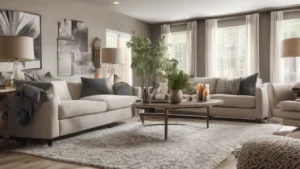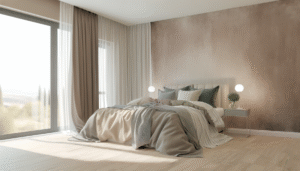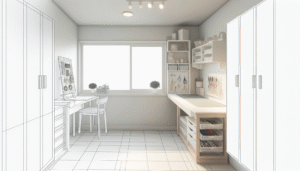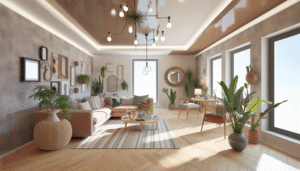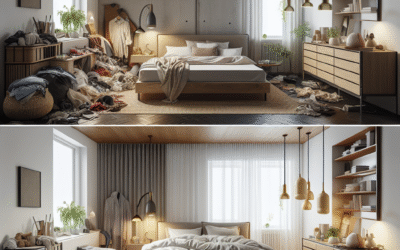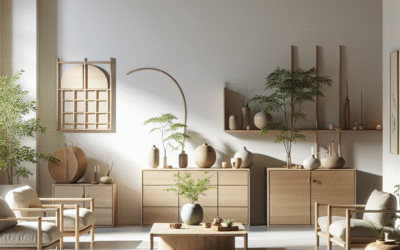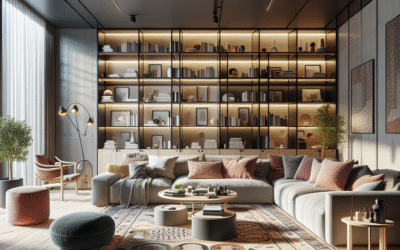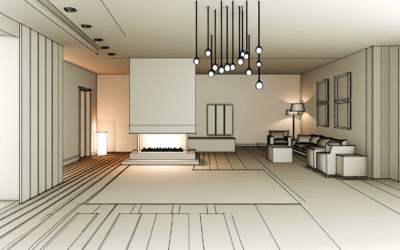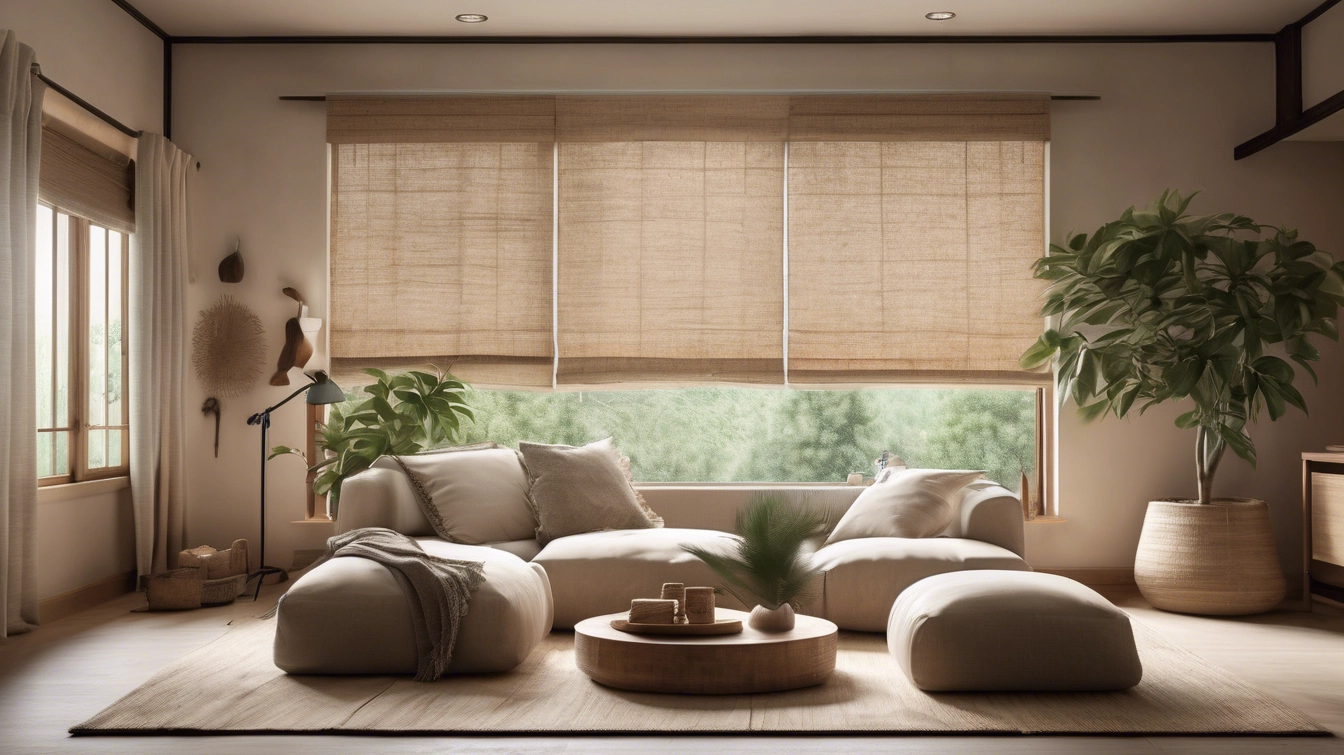
In our increasingly chaotic world, finding pockets of calm within our homes has become more than a luxury—it’s a necessity. Enter the beautiful, tranquil world of Japandi style minimalist curtains and blinds. This design philosophy, a harmonious blend of Japanese aesthetics and Scandinavian minimalism, offers a refreshing antidote to clutter and overstimulation. It’s about creating spaces that are not just visually appealing, but deeply calming and functional.
If you’re seeking to imbue your living spaces with an understated elegance, a connection to nature, and a profound sense of peace, Japandi is your answer. And when it comes to window treatments, its principles truly shine. Forget heavy drapes and fussy patterns; Japandi embraces clean lines, natural textures, and a thoughtful approach to light and privacy. This comprehensive guide will take you on a journey through the essence of Japandi design, specifically focusing on how selecting the right minimalist curtains and blinds can transform your home into a serene sanctuary. We’ll explore the core tenets, delve into material choices, color palettes, and practical applications, ensuring you have all the knowledge to infuse your space with this captivating style.
The Essence of Japandi: Where East Meets North
Before diving into specific window treatments, understanding the core philosophies behind Japandi style is crucial. It’s more than just a decor trend; it’s a lifestyle choice that values sustainability, craftsmanship, and quiet beauty. Picture the warm functionality of Scandinavian design, known for its hygge concept of coziness and well-being, fused with the refined elegance and wabi-sabi principles of Japanese aesthetics, which appreciate imperfection and transience.
Key Principles of Japandi Design
- Minimalism: Both styles champion simplicity, decluttering, and focusing on essential items. This isn’t about starkness but about purposeful living.
- Functionality: Beauty is derived from utility. Every piece serves a purpose, contributing to the overall harmony of the space.
- Natural Materials: Wood, bamboo, linen, cotton, and ceramics are staples. They bring warmth, texture, and a connection to the natural world.
- Neutral Color Palettes: Muted tones like whites, creams, greys, soft blues, and earthy browns form the base. Darker accents, often black, provide contrast and depth.
- Clean Lines & Forms: Clutter is avoided. Furniture and decor feature uncomplicated, streamlined silhouettes.
- Craftsmanship & Quality: A preference for well-made, durable items that stand the test of time, reflecting a respect for the artisan’s touch.
- Connection to Nature: Incorporating elements like plants, natural light, and organic textures to bring the outdoors in.
- Wabi-Sabi Inspiration: Accepting imperfection, valuing authenticity, and finding beauty in the aged and the natural.
When applying these principles to Japandi style minimalist curtains and blinds, the goal is to enhance light, provide privacy, and contribute to the room’s serene atmosphere without drawing undue attention to themselves. They should feel like a natural extension of the space, not a flamboyant addition.
Choosing the Right Window Treatments for Japandi Aesthetic
The selection of window treatments plays a pivotal role in achieving a cohesive Japandi look. They control light, offer privacy, and add texture. The emphasis is on simplicity, natural fibers, and subtle elegance.
Curtains vs. Blinds: Making the Minimalist Choice
Both curtains and blinds can work within a Japandi scheme, but certain types are more compatible than others. The choice often comes down to desired light control, privacy needs, and the specific architectural features of your windows.
Minimalist Curtains for Japandi Interiors
When opting for curtains, think sheer, lightweight, and unlined. The purpose is to diffuse harsh light, not block it entirely, allowing natural light to filter gently into the room. They should hang simply, without excessive gathers or decorative tie-backs.
- Linen Curtains: Hemp and linen are quintessential Japandi materials. Their natural texture, subtle slubs, and breathable quality make them ideal. They offer diffused light and a relaxed, organic feel.
- Cotton Voile: A softer, more delicate option that provides a beautiful, ethereal diffusion of light. Opt for unbleached or natural white tones.
- Sheer Fabrics: Generally, translucent or semi-sheer fabrics are preferred over blackout or heavy drapes. They maintain an open, airy feel.
- Simple Rods: Choose unobtrusive curtain rods in natural wood, matte black, or brushed metal. Avoid ornate finials.
- Length: Floor-length curtains are best, either hovering just above the floor or creating a slight ‘kiss’ on the floor for a relaxed look.
Minimalist Blinds and Shades for Japandi Interiors
Blinds and shades lean into the functional aspect of Japandi, offering precise control over light and privacy with clean lines. Many types embrace the natural materials and simplicity that define the style.
- Roller Blinds: The epitome of minimalism. When retracted, they virtually disappear. Choose natural fabrics like linen blends or light-filtering synthetics in muted tones.
- Roman Blinds: Offer a softer, tailored look than roller blinds, folding into neat pleats when raised. Again, stick to linen, cotton, or bamboo fabrics.
- Woven Wood Shades (Bamboo/Reed Blinds): These are fantastic for adding organic texture and warmth. They filter light beautifully, creating interesting shadow patterns without completely blocking views. Their natural imperfections align perfectly with wabi-sabi.
- Cellular (Honeycomb) Blinds: While not a natural material, their clean lines and excellent insulation properties in neutral colors can fit a Japandi scheme, especially where energy efficiency is a priority.
- Panel Track Blinds: Ideal for large windows or patio doors, these offer wide, vertical panels that slide open and closed, creating a sleek, contemporary look reminiscent of Japanese shoji screens. Use natural or subtly textured fabrics.
The key here is to avoid anything too ornate, shiny, or with busy patterns. The beauty lies in the fabric, texture, and how it interacts with light and the overall serenity of the room.
Color Palettes & Materials: The Japandi Spectrum
The Japandi palette is intentionally subdued, designed to evoke a sense of calm and openness. This approach extends directly to your choice of Japandi style minimalist curtains and blinds.
Embracing Earthy Tones and Neutrals
Think shades found in nature. Whites, off-whites, and creams form the base, providing a clean canvas. Layer these with soft greys, light browns, and muted blues or greens. Darker accents, often black or charcoal grey, are used sparingly to provide definition and anchor the space.
- White/Off-White: Creates airiness and bounces light, making spaces feel larger and brighter. Excellent for sheer curtains.
- Light Grey/Greige: A sophisticated neutral that adds subtle depth without overwhelming.
- Natural Linen/Beige: Embraces the raw, organic feel of true Japandi, bringing warmth and a connection to natural textiles.
- Muted Blue/Green: Used as very subtle accents, reminiscent of water, sky, or foliage, adding a calming touch without dominating.
- Charcoal/Black: For hardware (like curtain rods) or thin trims on blinds, providing a contemporary edge and grounding the lighter elements.
The Importance of Natural Materials
The tactile experience of a Japandi space is as important as the visual. Textures from natural materials are central to adding warmth and interest without relying on patterns or bright colors.
- Linen: The star player. Its slightly coarse yet soft feel, natural wrinkles, and excellent light diffusion are perfect.
“Linen is more than just a fabric; it’s a sensory experience. Its breathability and subtle unevenness embody the wabi-sabi appreciation for natural imperfections.” – Interior Designer, Anya Sharma.
- Cotton: Especially organic cotton, offers a softer hand than linen while maintaining breathability and a natural aesthetic.
- Bamboo: Highly sustainable and versatile. Woven bamboo shades provide privacy while filtering light, adding a distinct natural texture.
- Wood: Used in curtain rods, blind slats, or valances, wood brings warmth and connects the window treatments to other wooden elements in the room. Light woods like oak or ash are preferred.
- Hemp: Similar to linen in its sustainability and texture, hemp fabrics offer exceptional durability and a natural, earthy appeal for curtains.
Avoid synthetic fabrics that look plasticky or overly shiny, as these detract from the organic, natural feel of Japandi design. Focus on materials that feel good to touch and age gracefully.
Functionality Meets Form: Light Control & Privacy
In Japandi design, functionality is paramount. Window treatments are not just decorative; they actively contribute to the comfort and ambiance of a room through their ability to manage light and privacy.
Optimizing Natural Light
Japandi celebrates natural light. The goal isn’t to block it out entirely but to control its intensity and quality. Soft, diffused light creates a calming atmosphere, reducing glare while maintaining brightness.
- Sheer Curtains: Allow ample light in while providing a veil of privacy and softening harsh sunlight. They create a gentle, warm glow.
- Light-Filtering Blinds: Materials like woven woods, semi-transparent roller blinds, or light-filtering cellular shades can diffuse light effectively without plunging the room into darkness.
- Layering: For areas requiring more privacy or light blockage at certain times (like bedrooms), consider layering. A sheer curtain for daytime softness can be combined with a subtle blackout roller blind or a heavier, unlined linen Roman blind for night. The key is that the blackout layer should be unobtrusive when not in use.
The ability to adjust natural light throughout the day is a core aspect of Japandi living. Consider top-down/bottom-up features on blinds for ultimate flexibility, allowing light in from the top while maintaining privacy below.
Ensuring Privacy
While openness is valued, privacy is also essential for creating a truly comfortable sanctuary. Japandi window treatments offer solutions that are subtle yet effective.
- Roller Blinds & Roman Blinds: Provide full privacy when lowered. Choose fabrics with a tighter weave.
- Woven Wood Shades: Their natural variations and texture offer a surprising degree of privacy while still letting some light filter through. Lines and shadows make it difficult to see clearly through them.
- Combination Approaches: In a living room, sheer curtains might be sufficient, while a bedroom might benefit from a layered approach of a sheer curtain with an underlying room-darkening blind for nighttime.
- Panel Blinds: For large glass areas, panel blinds slide across, offering complete privacy when needed, mimicking traditional Japanese screens.
The beauty of Japandi is that privacy is achieved not through heavy, imposing fabrics, but through thoughtful material choices and adaptable designs that provide control without sacrificing the minimalist aesthetic.
Installation & Maintenance for Lasting Serenity
Even the most beautiful Japandi style minimalist curtains and blinds require proper installation and care to maintain their clean look and extend their lifespan.
Seamless Installation Techniques
The goal is an unobtrusive, integrated look. This means thoughtful placement and hardware selection.
- Inside Mount vs. Outside Mount:
- Inside Mount: Preferred for blinds and shades as it fits snugly within the window frame, creating a very clean, built-in look. This emphasizes the window’s architectural lines.
- Outside Mount: Sometimes necessary for curtains or if the inside frame lacks depth. For curtains, install rods wide enough so the fabric can be pulled completely past the window glass, maximizing light.
- Unobtrusive Hardware: For curtains, select simple, slim rods in matte black, brushed steel, or natural wood. Avoid ornate finials. For blinds, systems that hide the operating mechanisms are preferred.
- Precise Fit: Custom-made window treatments ensure a perfect fit, which is crucial for the clean lines inherent in Japandi design. Off-the-shelf options might compromise the minimalist aesthetic with ill-fitting gaps or bunched fabric.
When installing curtains, ensure they are hemmed to the correct length – either “kissing” the floor or just floating above it for a crisp, clean appearance. Avoid pooling fabric, as it can look messy and collect dust.
Care and Cleaning Tips for Longevity
Natural materials like linen and bamboo are durable but benefit from proper care to maintain their beauty.
| Material | Care Tips | Frequency |
|---|---|---|
| Linen/Cotton Curtains | Gentle machine wash with mild detergent (cold water, delicate cycle) or dry clean. Hang to dry. Iron on low/medium if desired, appreciating natural wrinkles. | Every 6-12 months (or as needed) |
| Roller Blinds (Fabric) | Dust regularly with a microfibre cloth or soft brush. Spot clean with mild soap and water for marks. Refer to manufacturer’s instructions for deep cleaning. | Weekly dusting, spot clean as needed |
| Roman Blinds (Fabric) | Similar to curtains for fabric type. Remove from hardware if detachable for full cleaning. Deep clean professionally if heavily soiled. | Bi-monthly dusting, professional clean annually |
| Woven Wood/Bamboo Blinds | Dust with a feather duster, soft brush, or vacuum with brush attachment. Spot clean with a damp cloth; avoid excessive water. | Weekly dusting |
| Cellular Blinds | Lightly vacuum with brush attachment. Compressed air can clean inside the cells. Spot clean with a damp cloth. | Monthly dusting |
Regular maintenance, particularly dusting, prevents dirt buildup and helps preserve the fresh, inviting look of your Japandi window treatments. Embracing the natural wear and slight imperfections that develop over time also aligns with the wabi-sabi philosophy, viewing them as part of the material’s story.
Integrating Window Treatments with Overall Japandi Decor
Window treatments aren’t standalone elements; they are integral to the holistic Japandi design. Their effectiveness is amplified when they harmonize with the rest of your interior scheme.
Complementing Furniture and Textiles
Your Japandi style minimalist curtains and blinds should echo the textures and colors of your furniture and other textiles, creating a cohesive visual flow.
- Wood Tones: If your furniture is light oak or ash, choose curtain rods in similar light wood tones or subtle matte black for contrast.
- Upholstery: Look for textiles on sofas and chairs that share the same natural fibers—linen, cotton, wool. This reinforces the material palette.
- Rugs: Opt for natural fiber rugs like jute, sisal, or understated wool rugs. The textures will complement the window treatments beautifully. A natural rug helps anchor a living room, creating visual warmth that extends to the window frame.
The goal is to create a sense of quiet dialogue between all elements, where each piece subtly enhances the others without competing for attention.
Harmonizing with Wall Colors and Lighting
The interplay of wall color and lighting is crucial for evoking the Japandi serene ambiance.
- Wall Colors: Stick to the neutral palette—whites, off-whites, greys, and muted earthy tones. These allow the natural light and the textures of the window treatments to shine.
- Layered Lighting: Complement natural light with thoughtful artificial lighting. Think soft, warm ambient light from minimal lamps, or indirect lighting that highlights architectural features. Avoid harsh overhead lighting.
- Reflective Surfaces: While minimalism reigns, a carefully placed mirror can amplify light and expand a space. Its clean lines align perfectly.
Consider how light changes throughout the day. Your Japandi style minimalist curtains and blinds should work effortlessly to manage this transition, from bright morning light to the soft glow of evening, always contributing to a feeling of calm.
Case Studies & Inspiration: Japandi Window Treatment in Practice
Let’s look at how Japandi style minimalist curtains and blinds manifest in different rooms and real-world scenarios, providing concrete examples of these principles in action.
Living Room Serenity: Sheer Linen & Subtle Blinds
Imagine a living room with large windows facing west. To manage the intense afternoon sun while maintaining an open feel, sheer linen curtains in an off-white hue are installed. They hang on a thin, matte black rod, extending slightly beyond the window frame to allow for maximum daylight when open. For ultimate sun control or privacy in the evening, a hidden, light-filtering roller blind in a complementary natural beige is installed as an inside mount, retracting almost invisibly when not in use. The soft light filtering through the linen creates gentle shadows, enhancing the room’s minimalist decor of a low-slung, neutral sofa and an unfinished wood coffee table. This example shows how Japandi successfully blends both “soft” and “hard” textures from different window coverings to meet unique demands.
Bedroom Haven: Layered Roman Blinds & Curtains
In a bedroom, deeper privacy and light control are usually required. Here, a full blackout Roman blind made from a slightly textured grey-brown linen blend is installed inside the window frame. Overlapping this, on an outside mount, are full-length, unlined hemp curtains in a soft cream color. During the day, the Roman blind is neatly folded up, and the hemp curtains are drawn open, letting in plenty of diffused light and showing off their beautiful, raw texture. At night, the Roman blind is lowered for complete darkness and privacy. This layered approach provides maximum flexibility without compromising the clean lines or natural feel, making it easier to create a sleep-friendly environment designed to support relaxation.
Kitchen/Dining Nook Simplicity: Woven Wood Shades
For a kitchen or dining area where a natural, organic touch is desired and views might be less critical, woven wood shades are an excellent choice. Made from natural reeds or bamboo, these shades bring an immediate sense of warmth and texture. They filter light beautifully, creating a dappled effect that adds interest without being busy. When raised, they stack neatly at the top of the window, leaving the view unobstructed. When lowered, they provide privacy while still allowing some light to pass through, avoiding a closed-off feeling. Their earthy tones complement natural wood cabinetry and simple ceramic tableware, reinforcing the overall Japandi aesthetic.
These examples illustrate how diverse Japandi style minimalist curtains and blinds can be, yet always adhering to the core principles of simplicity, natural materials, and thoughtful functionality. The emphasis remains on quality, understated elegance, and the creation of a serene living environment.
Beyond the Window: Embracing a Japandi Lifestyle
Selecting the perfect Japandi style minimalist curtains and blinds is a significant step, but the philosophy truly flourishes when integrated into a broader lifestyle. This involves more than just decor; it’s about mindful consumption, sustainable choices, and finding beauty in simplicity.
Minimalism as a Mindset
Japandi encourages decluttering not just physical spaces but mental ones too. Applying this to your home means:
- Fewer, Better Things: Prioritize quality over quantity. Invest in well-made items that stand the test of time and truly serve a purpose. This reduces waste and enhances appreciation for your belongings.
- Intentional Purchases: Before buying, consider if an item adds value, beauty, or functionality to your space. Avoid impulse buys.
- Regular Purging: Periodically assess your belongings and let go of what no longer serves you. This creates space and clarity.
This minimalist mindset extends to all areas of the home, promoting tidiness and ease of maintenance, which is reflected in the clean lines of Japandi style minimalist curtains and blinds. For more insights on decluttering, consider resources from reputable organizers or minimalist lifestyle blogs that often share practical tips.
Sustainability: A Core Japandi Value
The emphasis on natural, durable materials in Japandi design inherently promotes sustainability. Choose window treatments made from:
- Renewable Resources: Linen, cotton, bamboo are all renewable. Look for organic or ethically sourced certifications.
- Durable Construction: Investing in well-made curtains and blinds means they will last longer, reducing the need for frequent replacements.
- Energy Efficiency: Smart window treatments, like cellular blinds, can contribute to energy savings by providing insulation, reducing your carbon footprint.
By making conscious choices about the origin and longevity of your home goods, you embody the Japandi commitment to environmental responsibility. This philosophy permeates every decision, including your selection of Japandi style minimalist curtains and blinds.
Explore resources like the Forest Stewardship Council (FSC) or organizations promoting organic textile certification for more information on sustainable materials.
Connecting with Nature Indoors
Japandi design consistently brings the outdoors in, creating a harmonious environment. Beyond natural window treatments, consider:
- Houseplants: Carefully chosen, sculptural plants (like snake plants, ZZ plants, or Fiddle Leaf Figs) add life and color while aligning with the minimalist aesthetic.
- Natural Light: As discussed, maximize and expertly diffuse natural light.
- Organic Accents: Incorporate elements like pebbles, branches, or natural wood sculptures.
- Neutral Backdrop: Allow your window treatments to work with the neutral walls and earth-toned furnishings, ensuring that the connection to nature feels seamless and calming.
Every element in a Japandi home is chosen for its ability to foster a sense of peace and connection to the natural world, and your choice of Japandi style minimalist curtains and blinds is a key part of this holistic approach.
Common Questions About Japandi Window Treatments
Here are some frequently asked questions to help you further clarify your choices for Japandi style minimalist curtains and blinds.
What is the main difference between Japandi and traditional Scandinavian design for window treatments?
Japandi style for window treatments introduces a stronger emphasis on raw, natural textures and often incorporates darker, grounding accents like black or charcoal hardware, a nod to Japanese aesthetics. Traditional Scandinavian might lean more towards brighter whites and blonde woods, often featuring bolder patterns (though still minimalist) or a slightly more rustic feel, whereas Japandi is more refined and subdued.
Can I use Japandi style curtains in a small room?
Absolutely! Japandi principles, especially minimalism and maximizing natural light, are perfect for small rooms. Sheer, light-colored curtains will enhance spaciousness, and roller or Roman blinds offer sleek, space-saving solutions that don’t add visual bulk. Focus on light, airy fabrics and simple designs.
Are blackout blinds suitable for a Japandi bedroom?
Yes, but with thought. While Japandi celebrates natural light, practical needs like sleep are paramount. Opt for a blackout blind that can be discreetly tucked away (e.g., inside mount roller blind) behind a light-filtering sheer curtain or Roman blind. The key is that the blackout function is present but not visually dominant during the day.
What are the best materials for durability in Japandi blinds?
Linen, hemp, and high-quality cotton blends are very durable for fabric blinds and curtains. For woven shades, bamboo and natural reeds are robust. Always check the manufacturer’s care instructions and ensure the operating mechanisms for any blind system are well-constructed for longevity.
How do I clean woven wood or bamboo blinds effectively?
Regular light dusting with a feather duster, soft cloth, or vacuum cleaner with a brush attachment is recommended. For deeper cleaning, spot clean with a very lightly dampened cloth, being careful not to oversaturate the natural material. Avoid harsh chemicals or excessive scrubbing. Always follow specific manufacturer guidelines.
Can I mix and match different Japandi window treatment styles in one home?
Yes, and it’s often encouraged for functionality! For example, sheer linen curtains in the living room and discreet Roman blinds in the bedroom. The coherence comes from sticking to the Japandi palette (neutrals, natural
The coherence comes from sticking to the Japandi palette (neutrals, natural materials) and ensuring clean lines across all choices. The common thread should be simplicity and harmony.
What’s a budget-friendly way to achieve the Japandi curtain look?
Focus on simple, unlined cotton or linen blend fabrics in natural or off-white colors. Look for ready-made curtains with a plain top (like rod pocket or tab top, which can be modified) and choose basic, slim curtain rods in matte black or unfinished wood. Opt for fewer, wider panels rather than many small ones to maintain the clean, expansive feel.
Should Japandi curtains touch the floor or hover above it?
For a true Japandi look, curtains should either ‘kiss’ the floor (barely touching) or hover a precise half-inch to an inch above it. This maintains the clean, tailored line essential for the minimalist aesthetic. Avoid puddling fabric on the floor, as it can appear messy and accumulate dust, going against the principles of simplicity and cleanliness.
Conclusion: Cultivating Serenity with Japandi Window Treatments
The journey to creating a home that embodies the essence of Japandi style is one of thoughtful intention and quiet beauty. By focusing on Japandi style minimalist curtains and blinds, you are taking a crucial step towards transforming your living spaces into havens of serenity and functional elegance. We’ve explored how materials like linen, bamboo, and cotton, coupled with a palette of soft neutrals and earthy tones, can work in harmony with clean lines and natural light to create an environment that feels both grounded and expansive.
Remember, the core of Japandi isn’t just about aesthetics; it’s about a lifestyle that values authenticity, sustainability, and mindful living. Your window treatments, whether they are flowing sheer curtains or sleek roller blinds, are more than mere coverings; they are integral components that control ambiance, privacy, and the delicate dance of light within your home. Embrace the imperfections, appreciate the natural textures, and choose pieces that resonate with a deeper sense of tranquility. By doing so, you’ll not only achieve a visually stunning Japandi interior but also cultivate a more peaceful and balanced daily existence—a true sanctuary from the outside world. Start your journey today by assessing your natural light, identifying your privacy needs, and exploring the beautiful world of natural fabrics and minimalist designs. Your path to a truly harmonious home begins at the window.
Content Disclaimer
The information provided in this article is for general informational and educational purposes only and is not intended as interior design advice. While we strive for accuracy, individual results may vary based on specific circumstances, room dimensions, natural light conditions, and personal preferences. Always consult with a qualified interior designer or product specialist for personalized recommendations and professional installation.
Categories
- Accent Walls & Ceilings (61)
- Art Curation & Gallery (62)
- Bedding Style Trends (68)
- Bedroom Makeover (81)
- Bohemian & Eclectic Styles (58)
- DIY & Budget-Friendly Decor (63)
- Eco-Friendly Design (62)
- Furniture Care (71)
- Home Decor & Design Ideas (163)
- Home Wellness Spaces (59)
- Integrated Outdoor Living (67)
- Japandi Style (61)
- Kids and Nursery Decor (59)
- Living Room Decor (79)
- Mix & Match Techniques (73)
- Modern & Contemporary Design (66)
- Rug Sizing & Placement (73)
- Scandinavian Design Inspiration (12)
- Seasonal Home Decor (80)
- Small Space Solutions (73)
- Wall Art & Painting Tips (77)
Recent Comments
Archives
Product Gallery
-
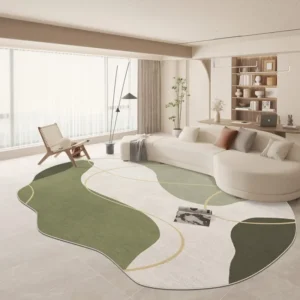 Large Area Green Rugs for Bedroom Nordic Living Room Decoration Shaped Carpet Irregular Plush Lounge Rug Home Thick Washable Mat
Rated 5.00 out of 5$54.94 – $346.41Price range: $54.94 through $346.41
Large Area Green Rugs for Bedroom Nordic Living Room Decoration Shaped Carpet Irregular Plush Lounge Rug Home Thick Washable Mat
Rated 5.00 out of 5$54.94 – $346.41Price range: $54.94 through $346.41 -
 Nordic Style Rugs for Bedroom Morandi Living Room Decoration Carpet Large Area Geometry Lounge Rug Home Cloakroom Non-slip Mat
Rated 5.00 out of 5$39.46 – $597.66Price range: $39.46 through $597.66
Nordic Style Rugs for Bedroom Morandi Living Room Decoration Carpet Large Area Geometry Lounge Rug Home Cloakroom Non-slip Mat
Rated 5.00 out of 5$39.46 – $597.66Price range: $39.46 through $597.66 -
 Irregular Shapes Living Room Decoration Carpet Modern Style Rugs for Bedroom Home Thicken Plush Rug Fluffy Soft Lounge Floor Mat
Rated 4.85 out of 5$55.84 – $347.37Price range: $55.84 through $347.37
Irregular Shapes Living Room Decoration Carpet Modern Style Rugs for Bedroom Home Thicken Plush Rug Fluffy Soft Lounge Floor Mat
Rated 4.85 out of 5$55.84 – $347.37Price range: $55.84 through $347.37

